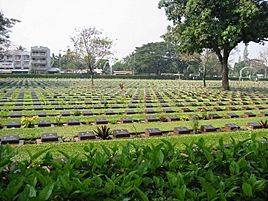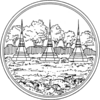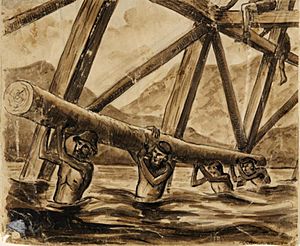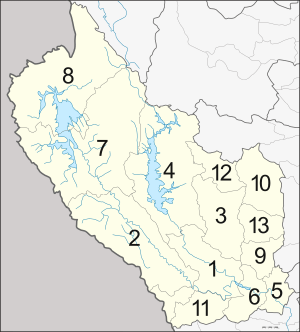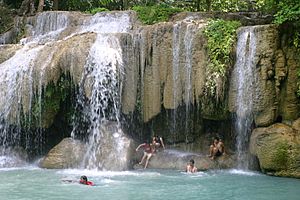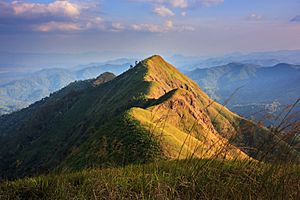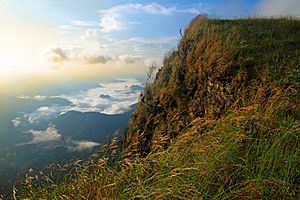Kanchanaburi province facts for kids
Quick facts for kids
Kanchanaburi
กาญจนบุรี
|
|||
|---|---|---|---|
|
From left to right, top to bottom : Kanchanaburi City Gate, Erawan National Park, Kanchanaburi Road, Burma Railway, Kanchanaburi War Cemetery
|
|||
|
|||
| Nickname(s):
Mueang Kan
|
|||
| Motto(s):
"แคว้นโบราณ ด่านเจดีย์ มณีเมืองกาญจน์ สะพานข้ามแม่น้ำแคว แหล่งแร่น้ำตก" ("Ancient region, Chedi checkpoint, Manee Mueang Kan, Bridge on the River Kwai and Mineral waterfalls")
|
|||
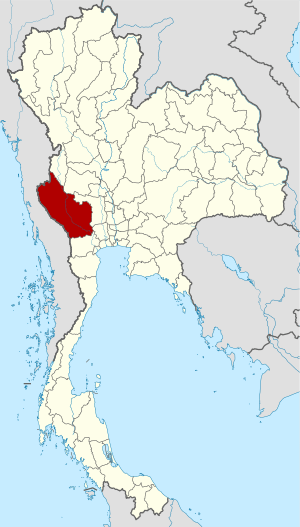
Map of Thailand highlighting Kanchanaburi province
|
|||
| Country | Thailand | ||
| Capital | Kanchanaburi | ||
| Area | |||
| • Total | 19,483 km2 (7,522 sq mi) | ||
| Area rank | Ranked 3rd | ||
| Population
(2018)
|
|||
| • Total | 893,151 | ||
| • Rank | Ranked 26th | ||
| • Density | 46/km2 (120/sq mi) | ||
| • Density rank | Ranked 74th | ||
| Time zone | UTC+7 (ICT) | ||
| Postal code |
71xxx
|
||
| Calling code | 034 | ||
| ISO 3166 code | TH-71 | ||
| Vehicle registration | กาญจนบุรี | ||
Kanchanaburi (Thai: กาญจนบุรี) is the biggest province in western Thailand. It shares borders with other Thai provinces like Tak and Ratchaburi. To its west, it also borders parts of Myanmar.
This province is famous for its long history and the well-known Bridge over the River Kwai. The river's name was originally "Khwae" but was changed to "Kwai" to match what tourists expected after a famous movie.
Contents
Geography of Kanchanaburi
Kanchanaburi province is located in western Thailand, about 129 kilometers (80 miles) from Bangkok. It covers a large area of about 19,483 km2 (7,522 sq mi). This makes it the third-largest province in Thailand.
The land is mostly covered with thick forests, including timber and evergreen trees. About 61.9% of the province is forest. Two important rivers, the Kwae Yai and Kwae Noi (also known as the "River Kwai"), start in this area. They join together in Kanchanaburi city to form the Mae Klong River.
A border crossing point called Bong Ti is located here. It might become very important in the future. This is because of a planned deepwater port project in Dawei, Myanmar. This project includes building a highway and a railway line connecting Bangkok to the port.
National Parks and Wildlife Areas
Kanchanaburi is home to many beautiful natural areas. These include national parks and wildlife sanctuaries. They are part of the Tenasserim Hills mountain range.
National Parks
There are seven national parks in the province:
- Khuean Srinagarindra National Park, covering 1,532 km2 (592 sq mi)
- Khao Laem National Park, covering 1,497 km2 (578 sq mi)
- Thong Pha Phum National Park, covering 1,236 km2 (477 sq mi)
- Lam Khlong Ngu National Park, covering 673 km2 (260 sq mi)
- Erawan National Park, covering 550 km2 (210 sq mi)
- Sai Yok National Park, covering 500 km2 (190 sq mi)
- Chaloem Rattanakosin National park, covering 59 km2 (23 sq mi)
Wildlife Sanctuaries
There are also two important wildlife sanctuaries:
- Thung Yai Naresuan West Wildlife Sanctuary, covering 2,130 km2 (820 sq mi)
- Salak Phra Wildlife Sanctuary, covering 859 km2 (332 sq mi)
History of Kanchanaburi
Evidence shows that people lived in Kanchanaburi as far back as the 4th century. They even traded with nearby areas. Not much is known about the Khmer Empire's influence here. However, Prasat Muang Sing, a famous Khmer site, proves they were once in the area.
Most of Kanchanaburi's recorded history starts around the time of King Rama I. Some historians believe the province was very important during the Ayutthaya period. This is because it was a common route for invasions from Burma. In 1982, old human and elephant bones, along with swords, were found in Phanom Thuan District. This led some to think it might have been the site of a famous battle. This battle was fought by King Naresuan against the Burmese crown prince.
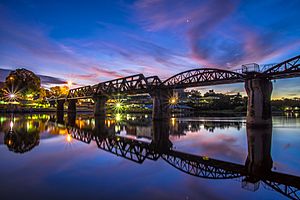
Many people around the world know Kanchanaburi because of its role in World War II. During the Japanese occupation of Thailand in 1942, a railway was built connecting Thailand and Burma. This railway is known as the Burma Railway. Both Allied prisoners of war (POWs) and Asian laborers were forced to build it. Sadly, over 100,000 people died due to the terrible working conditions. This included 16,000 Allied POWs and 90,000 local Asian laborers.
Symbols of Kanchanaburi
The official seal of the province shows three stupas (dome-shaped structures) on Bantadthong Mountain. These stupas give their name to the "Three Pagodas Pass", a mountain pass leading to Myanmar.
The provincial flower is the beautiful night-flowering jasmine. The provincial tree is the Moulmein lancewood. For its aquatic animal, the province chose the Jullien's golden carp.
The provincial slogan describes the area well: "A province of ancient community, three pagodas pass, precious stones, River Kwae Bridge, minerals and waterfall resources."
Administrative Divisions
Kanchanaburi is divided into 13 main areas called districts (amphoe). These districts are further split into 98 subdistricts (tambon) and 887 villages (muban).
The 13 districts are:
- Mueang Kanchanaburi
- Sai Yok
- Bo Phloi
- Si Sawat
- Tha Maka
- Tha Muang
- Thong Pha Phum
- Sangkhla Buri
- Phanom Thuan
- Lao Khwan
- Dan Makham Tia
- Nong Prue
- Huai Krachao
Transport in Kanchanaburi
The main train station in Kanchanaburi is Kanchanaburi Railway Station. This station is important for both locals and tourists.
Economy and Tourism
Mining and Resources
In 1918, valuable sapphire deposits were found near Bo Ploi. This area became a major source of sapphires in the 1980s and 1990s.
Tourism in Kanchanaburi
Most of the tourist attractions in Kanchanaburi are connected to World War II history. The Thailand-Burma Railway Centre is a good place to learn about the history of the Burma Railway. There are also two war cemeteries. The Kanchanaburi War Cemetery is a very moving place to visit.
National Parks and Natural Wonders
Erawan National Park
Erawan National Park covers 550 km2 (210 sq mi) in western Thailand. It was established in 1975 and was Thailand's 12th national park. The main attraction is Erawan Falls. This waterfall is named after the erawan, a three-headed white elephant from Hindu mythology. The waterfall has seven tiers, which are said to look like the erawan. The park also has four caves: Mi, Rua, Wang Bahdan, and Phartat.
Thong Pha Phum National Park
Thong Pha Phum National Park is known for its many waterfalls and caves. The Chok Kradin waterfall drops 30 metres (100 ft) over a cliff. Another large waterfall is Khao Yai, which has three levels. Other waterfalls include Dip Yai, Bi Teng, and Huai Meuang. Khao Noi cave contains Buddha images. From the Khao Khat viewpoint, you can see amazing panoramic views of the park.
Khao Laem National Park
Khao Laem National Park is a large park of about 1,500 square kilometers in western Thailand. It is part of the Western Forest Complex, a protected wilderness area. The park surrounds the Khao Laem Reservoir. The area has different types of forests, including mixed deciduous and evergreen forests. It is next to the Thungyai Naresuan Wildlife Sanctuary. Large animals like tigers, elephants, and wild boars live here.
Sai Yok National Park
Sai Yok National Park is located in Sai Yok District. This park features mountains, waterfalls, and caves. It is also part of the Western Forest Complex. The main attractions are its waterfalls, especially Sai Yok Yai waterfall, which flows into the Khwae Noi river. Sai Yok Yai Lek waterfall is also nearby. The park has many caves. Tham Lawa is the largest, stretching 500 metres (1,600 ft). It has five big caverns with large stalactites and stalagmites. Another cave, Tham Daowadueng, is 100 metres (330 ft) long and was found in 1972. It has eight chambers filled with stalactites and stalagmites.
Notable People from Kanchanaburi
- Boonpong Sirivejjabhandu (1906–1982), a merchant
- Vajirañāṇasaṃvara (1913–2013), a very important Buddhist leader
- Prawase Wasi (born 1931), a doctor and public thinker
- Luang Por Dattajivo (born 1940), a Buddhist monk
- Chatchai Plengpanich (born 1960), an actor
- Sontirat Sontijirawong (born 1960), a politician
- Suchao Nuchnum (born 1983), a football player
- Weluree Ditsayabut (born 1992), Miss Universe Thailand 2014
See also
 In Spanish: Provincia de Kanchanaburi para niños
In Spanish: Provincia de Kanchanaburi para niños






